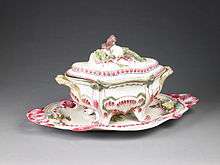Niderviller pottery

Niderviller (German Niederweiler) faience is one of the most famous French pottery manufacturers. It has been located in Niderviller, Lorraine, France since 1735. It also produced porcelain statues in the Meissen style starting in the mid-18th century.
History
In 1735, Anne-Marie Défontaine, a town noblewoman, decided to put her forests and quarries to a good use by starting a pottery works. She drew on local skills available in Lorraine to gather the proper staff.
In 1763, the company started producing porcelain objects, thanks to the help of workers recruited from Saxony.
Probably because of Sèvres' opposition to this, in 1770, the company was sold by Beyerlé to Adam Philippe, Comte de Custine.[1] Shortly after, it started producing fine earthenware products in the English style.
Tableware
-

Terrine dish, traditional Niderviller monochrome in pink, c. 1760
-

18th century statuette for salt & pepper, Niderviller,
-
"The broken clog", Niderviller, 18th century
-

Covered tureen, Niderviller exhibited in the Birmingham Museum and Art Gallery 18th century
-
18th century statuary group, Niderviller exhibited in the Sarrebourg Museum
-
covered milk jug Niderviller ca 1775. Gardiner Museum in Toronto.
-

porcelain basket, Niderviller, ca 1785. Hallwyl Museum in Stockholm.
Developments since 1827
The company was sold to a former partner of Villeroy & Boch in 1827.[2]
Museums exhibiting Niderviller ceramics
Many museums across the world display Niderviller products, including: the Louvre, the Musée des Arts Décoratifs, Paris, the Sèvres – Cité de la céramique, the Palace of the Dukes of Lorraine, the Musée des Arts décoratifs, Strasbourg, but also the Smithsonian Institution, Mount Vernon, the Philadelphia Museum of Art, the Art Institute of Chicago, the Metropolitan Museum of Art, the Museum of Anthropology at UBC in Vancouver, the Hallwyl Museum in Stockholm and museums in Hamburg, Berlin, Basel, Zürich[3]…
List of some designers and other artists involved with Niderviller
- Paul-Louis Cyfflé
- Charles-Gabriel Sauvage,[4] aka. Lemire
- Jean Boggio
- François-Antoine Anstette
- Jean-Louis Beyerle
- Mathias Lesprit
See also
References
Further reading
- Dorothée Guillemé Brulon (et al.), Histoire de la faïence française. Strasbourg-Niderviller : sources et rayonnement, C. Massin, Paris, 1999, 167 p. ISBN 2-7072-0345-9.
- Tardy & Adrien Lesur (1950). Les porcelaines françaises (Caractéristiques, marques) (in French). Aubenas: Tardy. p. 836. les porcelaines françaises.
- Jean-Louis Janin-Daviet, Hervé de la Verrie (October 2007). Mémoire d'une collection éphémère au Château d'Haroué (in French). Drulingen: imprimerie Scheuer. p. 187. ISBN 2-913162-71-1. Mémoire d'une collection éphémère.
- Chantal Soudée-Lacombe (February 1984). Faïenciers et Porcelainiers De Niderviller au XVIIIème siècle (collection: Le Pays Lorrain n°1) (in French). SHAL. p. 76. Faïenciers et Porcelainiers De Niderviller.
- Dominique Dubus, La famille Seeger : aperçu des manufactures de Niderviller et de la rue Pierre Levée à Paris aux XVIIIe et XIXe siècles, D. Dubus, Cauge, Évreux, 1984. ISBN 2-904815-01-5.
- Martine Hassenforder, Les faïenciers de Niderviller, Musée du pays de Sarrebourg, Sarrebourg, 1990, 100 p. ISBN 2-908789-07-8.
- Dominique Heckenbenner (dir.), Porcelaines de Niderviller (catalogue de l'exposition, Musée du pays de Sarrebourg, 29 June – 22 September 1996), Musée du pays de Sarrebourg, Sarrebourg, 1996. p. 72. ISBN 2-908789-12-4.
- Patrick Bichet & Henry Bourgon (February 2013). La Faïencerie De Niderviller (ses origines il y a 250 ans) (in French). Drulingen: SHAL. p. 55. ISBN 2-909433463. Faïencerie De Niderviller.
- Maurice Noël (1961). Recherches sur la céramique Lorraine (in French). Nancy, faculté de lettre. p. 225. thèse de IIIème cycle.
- Eileen Aldridge (1969). porcelain. London, UK: Paul Hamlyn. p. 160. ISBN 9780600001348. porcelain.
- William Chaffers (1912). Marks and Monograms On Pottery and Porcelain. London, UK: Reeves & Turner 83, Charing cross road. p. 1080.
External links
- Niderviller faience and associated Lorraine royal manufactories
- history of the Niderviller manufactory